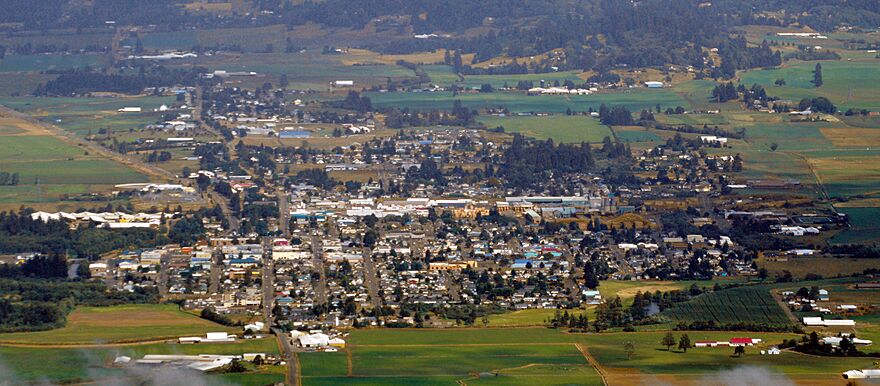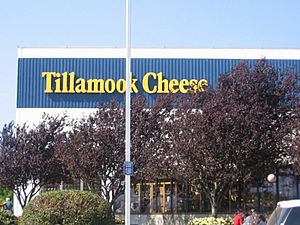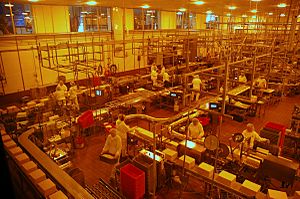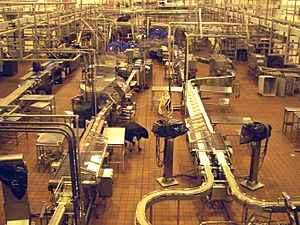Tillamook, Oregon facts for kids
Quick facts for kids
Tillamook, Oregon
|
|
|---|---|
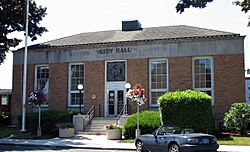
City hall
|
|
| Nickname(s):
Land of Many Waters; Land of Cheese, Trees, and Ocean Breeze
|
|
| Motto(s):
"Gateway to the Oregon Coast"
|
|
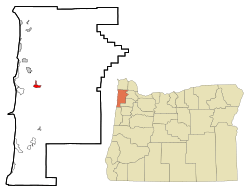
Location in Oregon
|
|
| Country | United States |
| State | Oregon |
| County | Tillamook |
| Incorporated | 1891 |
| Government | |
| • Body | City Council |
| Area | |
| • Total | 1.90 sq mi (4.93 km2) |
| • Land | 1.90 sq mi (4.93 km2) |
| • Water | 0.00 sq mi (0.00 km2) |
| Elevation | 33 ft (10 m) |
| Population
(2020)
|
|
| • Total | 5,204 |
| • Density | 2,733.19/sq mi (1,055.08/km2) |
| Time zone | UTC−8 (Pacific) |
| • Summer (DST) | UTC−7 (Pacific) |
| ZIP code |
97141
|
| Area code(s) | 503 |
| FIPS code | 41-73700 |
| GNIS feature ID | 2412070 |
| Website | www.tillamookor.gov |
Tillamook is a city in Oregon, United States. It's the main town, or county seat, of Tillamook County. You can find it on the southeast side of Tillamook Bay, right by the Pacific Ocean. In 2020, about 5,204 people lived there. The name Tillamook is pronounced TILL-ə-muuk.
Contents
History of Tillamook
Native American Roots: The Tillamook People
The city of Tillamook gets its name from the Tillamook people. They were a Native American tribe who spoke a Salishan language. They lived in this area until the early 1800s.
A scientist named Franz Boas said the Tillamook people were the most southern group of the Coast Salish peoples. These groups lived in the Pacific Northwest. Other tribes separated the Tillamook from their northern relatives. The name Tillamook comes from the Chinook language. It refers to people from a place called Elim or Kelim. The Tillamook people spoke their own language, which had two different ways of speaking. Their culture was unique and might have been influenced by tribes from what is now northern California.
Early European Arrivals and City Growth
In 1788, Captain Robert Gray was the first European to land on the Oregon coast. He dropped anchor in Tillamook Bay. Settlers started to arrive in the early 1850s. The area became Tillamook County in 1853.
The town of Tillamook was officially planned out in 1862. The first post office opened in 1866. In 1873, the town was chosen to be the county seat. Tillamook officially became a city in 1891.
Tillamook During World War II
During World War II, the United States Navy had a special station near Tillamook. It was a base for blimps, which are like large airships. These blimps helped patrol the coast. This station was called Naval Air Station Tillamook. It closed down in 1948. Today, the old blimp hangar is home to the Tillamook Air Museum.
Geography and Rivers
Tillamook covers about 1.7 square miles (4.4 square kilometers) of land. The area is known for its five rivers. These rivers are the Tillamook, Trask, Wilson, Kilchis, and the Miami. The Miami River is just north of the city.
Tillamook's Climate: Wet Winters and Mild Summers
Tillamook has a mild and wet climate. It's close to the Pacific Ocean, so temperatures don't change much. From November to April, it's cool and rainy. Daytime temperatures are usually between 40 and 50 degrees Fahrenheit (4-15 Celsius). It rains a lot, especially in November, December, and January. Snow is rare, but floods can happen in winter.
From April to October, it rains less than in other coastal cities. But it's still much wetter than cities in Oregon's Willamette Valley. For example, Tillamook gets about 88 inches (224 cm) of rain each year. Portland, a city in the Willamette Valley, only gets about 36 inches (91 cm).
Summers in Tillamook are short and mild. Average daytime temperatures are in the upper 60s Fahrenheit (15-20 Celsius). Sometimes, it can get hotter, reaching the 80s or 90s (27-32 Celsius). Summer is the driest time of year. July and August get only about 1.3 inches (3.3 cm) of rain.
| Climate data for Tillamook, Oregon (1991–2020 normals, extremes 1949–2021) | |||||||||||||
|---|---|---|---|---|---|---|---|---|---|---|---|---|---|
| Month | Jan | Feb | Mar | Apr | May | Jun | Jul | Aug | Sep | Oct | Nov | Dec | Year |
| Record high °F (°C) | 70 (21) |
78 (26) |
78 (26) |
86 (30) |
88 (31) |
87 (31) |
88 (31) |
89 (32) |
97 (36) |
92 (33) |
80 (27) |
69 (21) |
97 (36) |
| Mean maximum °F (°C) | 62.1 (16.7) |
64.7 (18.2) |
67.8 (19.9) |
71.5 (21.9) |
76.5 (24.7) |
76.0 (24.4) |
78.1 (25.6) |
79.8 (26.6) |
81.7 (27.6) |
76.1 (24.5) |
65.2 (18.4) |
60.1 (15.6) |
85.9 (29.9) |
| Mean daily maximum °F (°C) | 51.9 (11.1) |
53.1 (11.7) |
54.8 (12.7) |
57.2 (14.0) |
61.1 (16.2) |
64.1 (17.8) |
67.7 (19.8) |
69.0 (20.6) |
68.4 (20.2) |
62.5 (16.9) |
55.5 (13.1) |
50.6 (10.3) |
59.7 (15.4) |
| Daily mean °F (°C) | 44.5 (6.9) |
44.7 (7.1) |
46.0 (7.8) |
48.3 (9.1) |
52.4 (11.3) |
55.9 (13.3) |
59.0 (15.0) |
59.7 (15.4) |
57.6 (14.2) |
52.6 (11.4) |
47.2 (8.4) |
43.5 (6.4) |
51.0 (10.6) |
| Mean daily minimum °F (°C) | 37.2 (2.9) |
36.3 (2.4) |
37.2 (2.9) |
39.4 (4.1) |
43.7 (6.5) |
47.7 (8.7) |
50.3 (10.2) |
50.3 (10.2) |
46.8 (8.2) |
42.7 (5.9) |
39.0 (3.9) |
36.4 (2.4) |
42.3 (5.7) |
| Mean minimum °F (°C) | 25.2 (−3.8) |
25.0 (−3.9) |
27.2 (−2.7) |
31.1 (−0.5) |
33.9 (1.1) |
38.1 (3.4) |
41.5 (5.3) |
40.9 (4.9) |
36.1 (2.3) |
30.8 (−0.7) |
26.8 (−2.9) |
23.9 (−4.5) |
20.7 (−6.3) |
| Record low °F (°C) | 1 (−17) |
5 (−15) |
18 (−8) |
23 (−5) |
25 (−4) |
31 (−1) |
34 (1) |
33 (1) |
27 (−3) |
19 (−7) |
14 (−10) |
4 (−16) |
1 (−17) |
| Average precipitation inches (mm) | 13.38 (340) |
9.49 (241) |
10.05 (255) |
7.48 (190) |
4.56 (116) |
3.28 (83) |
0.92 (23) |
1.20 (30) |
3.58 (91) |
7.80 (198) |
13.44 (341) |
14.65 (372) |
89.83 (2,280) |
| Average snowfall inches (cm) | 0.0 (0.0) |
0.2 (0.51) |
0.0 (0.0) |
0.0 (0.0) |
0.0 (0.0) |
0.0 (0.0) |
0.0 (0.0) |
0.0 (0.0) |
0.0 (0.0) |
0.0 (0.0) |
0.0 (0.0) |
0.0 (0.0) |
0.2 (0.51) |
| Average precipitation days (≥ 0.01 in.) | 22.4 | 18.9 | 21.7 | 19.5 | 14.8 | 12.6 | 6.3 | 7.3 | 10.0 | 17.9 | 22.7 | 23.3 | 197.4 |
| Average snowy days (≥ 0.1 in) | 0.0 | 0.2 | 0.0 | 0.0 | 0.0 | 0.0 | 0.0 | 0.0 | 0.0 | 0.0 | 0.0 | 0.0 | 0.2 |
| Source: NOAA | |||||||||||||
Tillamook's Population and People
| Historical population | |||
|---|---|---|---|
| Census | Pop. | %± | |
| 1900 | 834 | — | |
| 1910 | 1,352 | 62.1% | |
| 1920 | 1,964 | 45.3% | |
| 1930 | 2,549 | 29.8% | |
| 1940 | 2,751 | 7.9% | |
| 1950 | 3,685 | 34.0% | |
| 1960 | 4,244 | 15.2% | |
| 1970 | 3,968 | −6.5% | |
| 1980 | 3,981 | 0.3% | |
| 1990 | 4,001 | 0.5% | |
| 2000 | 4,356 | 8.9% | |
| 2010 | 4,935 | 13.3% | |
| 2020 | 5,204 | 5.5% | |
| U.S. Decennial Census | |||
Who Lives in Tillamook? (2010 Census)
In 2010, about 4,935 people lived in Tillamook. There were 2,037 homes, with 1,192 being families. The city had about 2,903 people per square mile (1,121 per square kilometer).
Most residents (86.5%) were White. About 1.5% were Native American, and 1.1% were Asian. About 17.2% of the population was Hispanic or Latino.
About 33.5% of homes had children under 18. The average home had 2.41 people. The average family had 3.11 people. The average age in Tillamook was 33.7 years old. About 27% of people were under 18.
Tillamook's Economy and Industries
Historically, Tillamook's economy has relied on dairy farms. The land around the city is perfect for cows that produce milk. This milk is used by the Tillamook County Creamery Association. They make famous products like cheddar cheese, ice cream, and yogurt. About one million people visit the cheese factory each year. It's located north of Tillamook on Highway 101.
The lumber industry is also growing again. This is thanks to new trees planted after the Tillamook Burn forest fires. These fires happened in the mid-1900s. You can still see the remains of some burned trees in the forests.
Tillamook also welcomes many tourists. People visit on their way to the ocean beaches. Some people even have second homes here.
Arts, Culture, and Fun Places to Visit
Museums and Other Cool Spots
The Tillamook Air Museum is just south of the city. It has over 15 aircraft and many wartime items. The museum is inside a huge wooden hangar. This hangar was once part of Naval Air Station Tillamook during World War II. In 1991, the famous magician David Copperfield filmed a trick here. He made a train car disappear for a TV special. Another hangar next to it was destroyed by fire in 1992. These hangars were built with very old, large trees. You can see the huge, smooth wooden beams inside.
The Tillamook Cheese Factory is where the Tillamook County Creamery Association first started making cheese. It's also a Visitor Center. Over 1 million tourists visit every year. You can watch how cheese, ice cream, and other dairy products are made from a special viewing area. There are videos and interactive screens to help you learn. Tours inside the actual cheese-making area stopped in 1967 for safety reasons.
The Tillamook County Fair is famous for its annual Pig-N-Ford race. In this unique race, people have to catch a pig. Then, they race old Model T Fords around a track with the pig under one arm!
Education in Tillamook
Tillamook is part of the Tillamook School District. The city has seven schools and one college. These include Tillamook High School, Tillamook Junior High School, and Wilson River School. There's also Trask River High School, East Elementary School, South Prairie Elementary School, and Liberty Elementary School. For higher education, there's Tillamook Bay Community College.
Media and Local News
Tillamook's weekly newspaper is the Headlight-Herald. The city also has three radio stations. KTIL-FM plays country music. It has a morning show and a special interview section called "Tillamook Today." This show talks with local leaders and business owners. KTIL (AM) plays oldies music and broadcasts sports events. KDEP-FM used to play classic rock but now plays modern music. Some famous media people started their careers at KTIL. One example is Lars Larson, a well-known talk show host. He got his first job there at age 16.
Transportation Options
- Tillamook Airport
- Tillamook County Transportation District
- Port of Tillamook Bay Railroad
Notable People from Tillamook
- Peggy Caserta (1940–2024), businesswoman and writer
- Jerry Kilgore (born 1964), country singer
- Lars Larson (born 1959), conservative talk radio show host
- Bridget Marquardt (born 1973), actress and model
- Jacob Young (born 1979), soap opera actor
See also
 In Spanish: Tillamook para niños
In Spanish: Tillamook para niños


